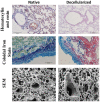Equine lung decellularization: a potential approach for in vitro modeling the role of the extracellular matrix in asthma
- PMID: 30450188
- PMCID: PMC6236489
- DOI: 10.1177/2041731418810164
Equine lung decellularization: a potential approach for in vitro modeling the role of the extracellular matrix in asthma
Abstract
Contrary to conventional research animals, horses naturally develop asthma, a disease in which the extracellular matrix of the lung plays a significant role. Hence, the horse lung extracellular matrix appears to be an ideal candidate model for in vitro studying the mechanisms and potential treatments for asthma. However, so far, such model to study cell-extracellular matrix interactions in asthma has not been developed. The aim of this study was to establish a protocol for equine lung decellularization that maintains the architecture of the extracellular matrix and could be used in the future as an in vitro model for therapeutic treatment in asthma. For this the equine lungs were decellularized by sodium dodecyl sulfate detergent perfusion at constant gravitational pressure of 30 cmH2O. Lung scaffolds were assessed by immunohistochemistry (collagen I, III, IV, laminin, and fibronectin), scanning electron microscopy, and DNA quantification. Their mechanical property was assessed by measuring lung compliance using the super-syringe technique. The optimized protocol of lung equine decellularization was effective to remove cells (19.8 ng/mg) and to preserve collagen I, III, IV, laminin, and fibronectin. Moreover, scanning electron microscopy analysis demonstrated maintained microscopic lung structures. The decellularized lungs presented lower compliance compared to native lung. In conclusion we described a reproducible decellularization protocol that can produce an acellular equine lung feasible for the future development of novel treatment strategies in asthma.
Keywords: Equine lung; asthma; decellularized; extracellular matrix; respiratory diseases.
Conflict of interest statement
Declaration of conflicting interests: The author(s) declared no potential conflicts of interest with respect to the research, authorship, and/or publication of this article.
Figures










Similar articles
-
Decellularization of Extracellular Matrix from Equine Skeletal Muscle.J Equine Vet Sci. 2020 Jul;90:102962. doi: 10.1016/j.jevs.2020.102962. Epub 2020 Mar 19. J Equine Vet Sci. 2020. PMID: 32534761
-
Decellularized Rat Lung Scaffolds Using Sodium Lauryl Ether Sulfate for Tissue Engineering.ASAIO J. 2018 May/Jun;64(3):406-414. doi: 10.1097/MAT.0000000000000654. ASAIO J. 2018. PMID: 28863041
-
Perfusion decellularization of human and porcine lungs: bringing the matrix to clinical scale.J Heart Lung Transplant. 2014 Mar;33(3):298-308. doi: 10.1016/j.healun.2013.10.030. Epub 2013 Oct 26. J Heart Lung Transplant. 2014. PMID: 24365767
-
Effects of two different decellularization routes on the mechanical properties of decellularized lungs.PLoS One. 2017 Jun 1;12(6):e0178696. doi: 10.1371/journal.pone.0178696. eCollection 2017. PLoS One. 2017. PMID: 28570606 Free PMC article.
-
Perfusion-Decellularization of Porcine Lung and Trachea for Respiratory Bioengineering.Artif Organs. 2015 Dec;39(12):1024-32. doi: 10.1111/aor.12481. Epub 2015 Apr 20. Artif Organs. 2015. PMID: 25894696
Cited by
-
Biological Graft as an Innovative Biomaterial for Complex Skin Wound Treatment in Dogs: A Preliminary Report.Materials (Basel). 2022 Sep 1;15(17):6027. doi: 10.3390/ma15176027. Materials (Basel). 2022. PMID: 36079408 Free PMC article.
-
Sodium Dodecyl Sulfate Analogs as a Potential Molecular Biology Reagent.Curr Issues Mol Biol. 2024 Jan 9;46(1):621-633. doi: 10.3390/cimb46010040. Curr Issues Mol Biol. 2024. PMID: 38248342 Free PMC article. Review.
-
ERS International Congress, Madrid, 2019: highlights from the Airway Diseases, Asthma and COPD Assembly.ERJ Open Res. 2020 Feb 17;6(1):00341-2019. doi: 10.1183/23120541.00341-2019. eCollection 2020 Jan. ERJ Open Res. 2020. PMID: 32083111 Free PMC article. Review.
-
Sterilization and disinfection methods for decellularized matrix materials: Review, consideration and proposal.Bioact Mater. 2021 Feb 27;6(9):2927-2945. doi: 10.1016/j.bioactmat.2021.02.010. eCollection 2021 Sep. Bioact Mater. 2021. PMID: 33732964 Free PMC article. Review.
-
Decellularised scaffolds: just a framework? Current knowledge and future directions.J Tissue Eng. 2020 Jul 22;11:2041731420942903. doi: 10.1177/2041731420942903. eCollection 2020 Jan-Dec. J Tissue Eng. 2020. PMID: 32742632 Free PMC article. Review.
References
-
- World Health Organization. Media centre fact sheets as of April 2017, http://www.who.int (accessed 3 September 2017).
-
- Clienti S, Morjaria JB, Basile E, et al. Monoclonal antibodies for the treatment of severe asthma. Curr Allergy Asthma Rep 2011; 11: 253–260. - PubMed
-
- Giembycz MA, Newton R. Harnessing the clinical efficacy of phosphodiesterase 4 inhibitors in inflammatory lung diseases: dual-selective phosphodiesterase inhibitors and novel combination therapies. Handb Exp Pharmacol 2011; 204: 415–446. - PubMed
-
- Nair P, Gaga M, Zervas E, et al. Safety and efficacy of a CXCR2 antagonist in patients with severe asthma and sputum neutrophils: a randomized, placebo-controlled clinical trial. Clin Exp Allergy 2012; 42: 1097–1103. - PubMed
LinkOut - more resources
Full Text Sources

